

Toolbox. Efficiency in Education - The Choice of Outcomes, The Choice of Inputs, The Transformation Process and Implications for Policy. Educators often feel ambivalent about the pursuit of efficiency in education.
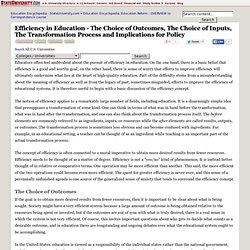
De la simplicité. Pourquoi ce billet?

Léonard de Vinci disait que la simplicité était la sophistication suprême. J’ai récemment lu un ouvrage intitulé “De la simplicité”. Son auteur se propose d’”atteindre la simplicité à l’ère numérique”. Face à l’accroissement exponentiel des données numériques disponibles, on parle aujourd’hui d’infobésité, ce type de réflexion me semble vraiment répondre à un problème actuel. Je me suis également intéressé à cet ouvrage car la simplicité s’insère dans le cadre de ma recherche sur la simplexité qui me paraît un des concepts clés du mind mapping. D’autre part, d’un point de vue plus strictement méthodologique, je trouve que certaines lois de la simplicité présentées ici, sont applicable pour la conception de cartes heuristiques. L’auteur John Maeda est une autorité mondialement reconnue dans le domaine du Web Design, il a été également professeur des arts et sciences numériques au fameux MIT à Boston. Pearltree sur la simplexité : billets, ouvrages….
Appréhender la complexité. Suite à ma petite sortie sur l'entreprise 2.0, beaucoup de choses très instructives se sont déroulées.
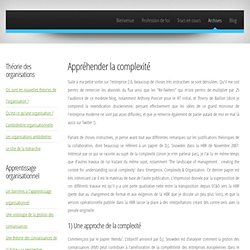
Qu'il me soit permis de remercier les abonnés du flux ainsi que les "Re-Twitters" qui m'ont permis de multiplier par 25 l'audience de ce modeste blog, notamment Anthony Poncier pour le RT initial, et Thierry de Baillon (dont je comprend la revendication druckerienne, pensant effectivement que les idées de ce grand monsieur de l'entreprise moderne ne sont pas assez diffusées, et que je remercie également de parler autant de moi en mal là aussi sur Twitter !).
Parlant de choses instructives, je pense avant tout aux différentes remarques sur les justifications théoriques de la collaboration, dont beaucoup se réfèrent à un papier de D.J. Snowden dans la HBR de Novembre 2007. 1) Une approche de la complexité Commençons par le papier 'étendu'. 1. 2) Le framework opérationnel 3) Les remarques et interrogations. Carte conceptuelle : la simplexité. Alain Berthoz nous parle de la simplexité. Une carte réalisée avec XMind à partir de l'entrevue vidéo d'Alain Berthoz La simplexité est un concept dont on parle depuis un certain nombre d'années, notamment dans les domaines du design, des mathématiques ou de la géologie.
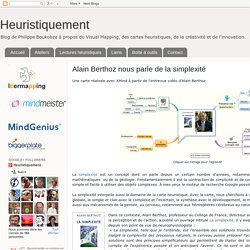
Fondamentalement il est la contraction de simplicité et de complexité. En Design, il consiste à rendre simple et facile à utiliser des objets complexes. À mes yeux le moteur de recherche Google possède des qualités simplexes. La simplexité interpelle aussi le domaine de la carte heuristique. Dans ce contexte, Alain Berthoz, professeur au Collège de France, directeur adjoint du Laboratoire de physiologie de la perception et de l’action, a publié un ouvrage intitulé La simplexité. . « La simplexité, telle que je l'entends, est l'ensemble des solutions trouvées par les organismes vivants pour que, malgré la complexité des processus naturels, le cerveau puisse préparer l'acte et en projeter les conséquences.
Entrevue vidéo où Alain Berthoz présente son ouvrage. Consumer analysis.
Current PMI Standards Projects. As the project management profession evolves, we continue to expand and update our library of standards.
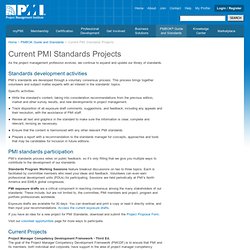
Standards development activities PMI’s standards are developed through a voluntary consensus process. This process brings together volunteers and subject matter experts with an interest in the standards’ topics. Specific activities: New Tools for Organizations. Enjoy more efficient access to the knowledge in PMI’s global standards and gain insight on your project management capabilities with PMI Standards Navigator and PMI Standards Benchmark.
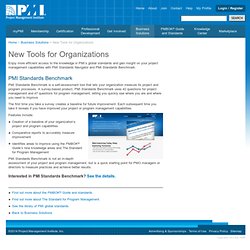
PMI Standards Benchmark is a self-assessment tool that lets your organization measure its project and program processes. A survey-based product, PMI Standards Benchmark uses 42 questions for project management and 47 questions for program management, letting you quickly see where you are and where you need to improve. Democratic Design - Principles. After over a decade of research into what organizational democracy is, we've discovered the ten principles that it takes to cultivate a highly successful and sustainable democratic workplace.

Work package. In project management, a work package (WP) is a subset of a project that can be assigned to a specific part for execution.

Because of the similarity, work packages are often misidentified as projects. Work packages are defined by brief statements of Activity Description, Activity Resources of Skill and Expertise, Activity Estimates of Effort and Duration, Activity Schedule, Activity Risks, and Activity Budget. Work Packages are assigned a Work Authorization or Control Account.[1] Roadmap. Un article de Wikipédia, l'encyclopédie libre.
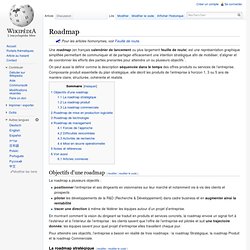
Une roadmap (en français calendrier de lancement ou plus largement feuille de route) est une représentation graphique simplifiée permettant de communiquer et de partager efficacement une intention stratégique afin de mobiliser, d’aligner et de coordonner les efforts des parties prenantes pour atteindre un ou plusieurs objectifs[1]. On peut aussi la définir comme la description séquencée dans le temps des offres produits ou services de l’entreprise. Composante produit essentielle du plan stratégique, elle décrit les produits de l’entreprise à horizon 1, 3 ou 5 ans de manière claire, structurée, cohérente et réaliste. Objectifs d'une roadmap[modifier | modifier le code]